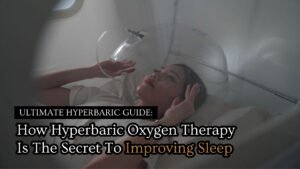Ringkasan ini membahas berbagai aspek gangguan hiperaktif defisit perhatian (ADHD) dan hubungannya dengan oksigen. Ini memeriksa penelitian tentang pendekatan pengobatan dan Memeriksa Dapatkah Oksigen Hiperbarik Benar-Benar Membantu ADHD. Dampak faktor yang berhubungan dengan oksigen pada ADHD, dan etiologi yang kompleks dari gangguan ini.
Hubungan dengan Oksigen:
Terapi oksigen hiperbarik (HBOT) muncul sebagai pendekatan pengobatan yang menjanjikan untuk ADHD dan gangguan belajar, seperti yang ditunjukkan dalam laporan kasus oleh Lee dkk. (2013). Pasien dalam penelitian tersebut menjalani HBOT bersama dengan akupunktur kulit kepala, terapi peningkatan kognitif, dan terapi wicara-bahasa, yang menghasilkan peningkatan dalam kemampuan kognitif, konsentrasi, komunikasi, gerak, kepercayaan diri, dan kondisi tidur.
Selain itu, hubungan antara faktor yang berhubungan dengan oksigen dan ADHD diselidiki dalam beberapa penelitian. Dalam sebuah penelitian oleh Kaiser Permanente (2012), ditemukan bahwa paparan dalam kandungan terhadap kondisi iskemik-hipoksia, yang melibatkan kekurangan oksigen ke otak, meningkatkan risiko pengembangan ADHD di kemudian hari. Hal ini menunjukkan bahwa kejadian selama kehamilan, seperti kekurangan oksigen, dapat berkontribusi pada terjadinya ADHD, di luar pengaruh genetik.
Penelitian lain oleh Lin dkk. (tahun) berfokus pada hubungan antara oksigen dan dopamin pada orang dewasa dengan ADHD. Penelitian ini mengungkapkan bahwa ketersediaan transporter dopamin dikaitkan dengan respons yang bergantung pada tingkat oksigen darah (BOLD) di daerah otak tertentu yang terlibat dalam pemrosesan hadiah. Hal ini menyoroti pengaruh mekanisme yang berhubungan dengan oksigen pada sistem dopaminergik dan implikasinya terhadap neurobiologi dan perilaku individu dengan ADHD.
Apa itu Terapi Oksigen Hiperbarik (HBOT), dan bagaimana hubungannya dengan ADHD?
HBOT melibatkan menghirup oksigen murni dalam ruang bertekanan. Beberapa pendukungnya menyarankan bahwa terapi ini dapat membantu mengatasi ADHD dengan meningkatkan kadar oksigen di otak, yang berpotensi meningkatkan fokus dan perhatian.
Apakah HBOT merupakan pengobatan yang terbukti untuk ADHD?
Tidak, HBOT bukanlah pengobatan yang terbukti atau disetujui FDA untuk ADHD. Meskipun ada beberapa bukti anekdot dan penelitian yang sedang berlangsung, tidak ada bukti ilmiah yang meyakinkan untuk mendukung efektivitasnya dalam mengobati ADHD.
Apakah ada risiko atau efek samping yang terkait dengan HBOT untuk ADHD?
HBOT umumnya dianggap aman jika dilakukan oleh tenaga profesional yang terlatih. Namun, risiko potensial termasuk barotrauma telinga, ketidaknyamanan sinus, dan, dalam kasus yang jarang terjadi, keracunan oksigen. Sangat penting untuk berkonsultasi dengan penyedia layanan kesehatan sebelum mempertimbangkan HBOT untuk ADHD.
Haruskah saya mempertimbangkan HBOT sebagai pilihan pengobatan untuk anak saya dengan ADHD?
Penggunaan HBOT untuk ADHD merupakan masalah perdebatan yang sedang berlangsung dalam komunitas medis. Sebelum mempertimbangkan HBOT, sangat penting untuk berkonsultasi dengan dokter anak atau spesialis ADHD untuk mengeksplorasi perawatan berbasis bukti dan membuat keputusan yang tepat.
Adakah pengobatan alternatif untuk ADHD yang telah terbukti efektif?
Ya, ada beberapa perawatan berbasis bukti untuk ADHD, termasuk terapi perilaku, pengobatan, dan intervensi gaya hidup. Perawatan ini telah dipelajari secara ekstensif dan umumnya dianggap sebagai standar perawatan untuk menangani ADHD. Sebaiknya diskusikan opsi-opsi ini dengan penyedia layanan kesehatan untuk menentukan pendekatan yang paling tepat untuk kebutuhan spesifik Anda atau anak Anda.
Kesimpulan:
Kesimpulannya, temuan dari penelitian ini menjelaskan hubungan multifaset antara ADHD dan oksigen. Anda mendapatkan jawaban dari Dapatkah Oksigen Hiperbarik Benar-Benar Membantu ADHD. HBOT, bersama dengan terapi lain, menunjukkan harapan dalam memperbaiki gejala ADHD dan gangguan belajar. Selain itu, kekurangan oksigen prenatal diidentifikasi sebagai faktor risiko potensial untuk perkembangan ADHD, menekankan pentingnya mempertimbangkan kejadian prenatal dalam memahami gangguan tersebut. Selain itu, hubungan antara faktor yang berhubungan dengan oksigen dan fungsi dopamin memberikan wawasan ke dalam proses neurobiologis yang mendasari ADHD. Temuan ini berkontribusi pada pengembangan strategi pengobatan yang komprehensif dan memperluas pemahaman kita tentang etiologi dan manajemen ADHD.
Referensi:
- Lee, S.-B., Lee, R.-D., Lee, S.-W., & Park, S.-J. (2013). Laporan Kasus Pasien dengan ADHD dan Gangguan Belajar yang Diobati dengan Terapi Oksigen Hiperbarik dan Terapi Medis Oriental. Departemen Neuropsikiatri Korea, Pusat Medis Korea Dong-Seo. J of Oriental Neuropsikiatri, 24 (4), 393-402.
- Kaiser Permanente. Science Daily (2012, Desember 10). ADHD terkait dengan kekurangan oksigen sebelum lahir.
- Lin, S.-H., Chi, M. H., Lee, I. H., Chen, K. C., Tai, Y. C., Yao, W. J., ... Yang, Y. K. (2020). Judul: Sebuah studi percontohan tentang hubungan antara sinyal yang bergantung pada tingkat oksigen darah dalam sistem penghargaan dan ketersediaan transporter dopamin pada orang dewasa dengan gangguan hiperaktif defisit perhatian. Spektrum SSP, Cambridge University Press, 26(3), 299-306.







